convert-png-to-jpeg
convert to png
JPG vs JPEG: Understanding the Most Common Image File Format
Webmasters encounter images constantly. Although you don't need to be an image expert to edit and upload images to websites however, it is essential to be familiar with the most common formats for files such as JPEG. Or is it JPG?
In this article, I'll present an JPG as well as a JPEG demonstration to help you appreciate the difference, as well and other info that will enable you to upload the finest images possible to your website for the ultimate user experience. If you're in search of an in-depth overview of the modern .webp file format is what you need, we've got your covered as well.
Ready? Let's get started!
Table of Contents
- What is JPEG?
- What is JPG?
- JPG vs JPEG: Similarities Between the Two
- JPG vs JPEG 2000
- Convert Image Files to JPG: Common Methods
convert to jpeg
If you are a webmaster working with images, you've likely encountered an image file in the format JPEG somewhere in your editing and uploading journeys.
Did you be aware that the term JPEG can actually be a term used to refer to three different things?
Well, it is and we're here for a thorough explanation of them:
1. JPEG Lossy Compression
When you upload images to your site It's essential to take care not to negatively impact your website's speed or performance by uploading large images which consume resources and take a long time to render on frontend of your site. In fact, all website owners must optimize their images by reducing the size of their images and preserve loading times and the user experience.
That's why JPEG comes in handy. JPEG is a lossy compression tool used to ensure the digital images being used are as small as they can be and load fast for those who want to view them.
Here are some things to consider about lossy compression:
- The file size of the image compressing is permanently reduced through getting rid of unnecessary ( redundant) informationfrom the image.
- The quality of images can be a problem although it's typically such that the average visitors aren't able tell.
- During compression, each pixel is compared to its neighbors in a ratio of 2:1 all the way until 100:1 ( any pixels that are similar to the original are then removed in the event that they are found to be to be redundant).
- JPEG lossy compression is often used to compress photographsand complex still images.
- The moment you compress an image using lossy compression, you decide the file size and image high-quality tradeoff ( e.g., smaller files are less quality).
- The more editing and saving of a single photo you make and save, the less professional the image of the image will be.
If you're experienced with editing images with lossy compression, there's an opportunity to preserve the image's quality, while reducing its file size by working with RAW JPEG images editing them, then saving the image once.
convert to bmp
If you're not keen to apply JPEG lossy compression on the images you upload to your website There's another option: lossless compression.
Lossless compression will save your images in a completely other format ( usually PNG). Although image quality cannot be diminished because it is not the case that information is lost, be aware that even with lossless compression, the final resolution of the photo you choose to save will be greater than that obtained with lossy compression. This could cause more time to load your pages.
2. Joint Photographic Experts Group (JPEG)
JPEG stands for the Joint Photographic Experts Group, that's the name of the sub-committee who helped develop the JPEG standard as well as the other still picture coding standards within the larger group known as ISO.
The first JPEG standard was issued on the 22nd of December 1992 ISO ( International Organization for Standardization). ISO are responsible for the creation of specifications which "...provide requirements and specifications, guidelines or specifications that can be followed consistently to ensure that the materials, products, processes, and services are fit for their purpose."
ISO establishes standard for many things, including digital images, in order to provide customers and clients with top quality products and services. 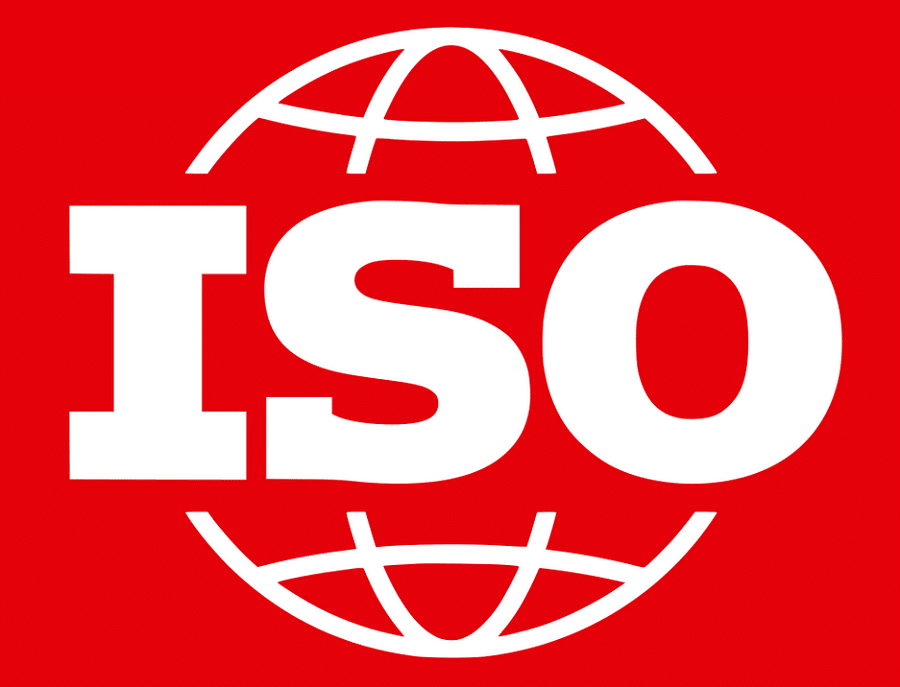
Image source: Wikimedia Commons
This international group is a open group of individuals with members in 164 countries, making it the world's biggest developer of standards.
3. JPEG as a File Format
The other way JPEG is used is when it refers to a name for a file format or as a method of storing pictures in digital format. This is most likely how you're familiar with JPEG because this is one of the formats for file options when you download an edited image. 
JPEG file format
Here are some fun facts about The .jpeg files format.
- Most commonly used image file standard used by DSLR cameras and other devices for image capture.
- Supports 16,777 colors. are created by using 8 bits of each color in the RGB models of color.
- Displays over 16 million colours at once The combination of color and resolution close to perfect.
- Supports a maximum of 65.535 x 65.535 pixels.
- It reduces the dimensions of images approximately 50-75% ( because of lossy compression) when saving
Lastly, this type of file format may not be suitable for images with sharp edges because the colors blend together better than if the image was saved as a .png or.jpg, which show every single pixel as a blend.
Now, let's figure out what JPG is.
What is JPG?
What is JPG relative in comparison to JPEG? 
File extensions in Windows
If you're looking for a way to compare to .jpeg vs .jpg, the truth is there is no difference between themexcept the number of characters.
Crazy right? Let us explain.
The term JPG was created by the earlier versions of Windows operating systems. Specifically, the MS-DOS 8.3 and the FAT-16 system had a limit of 3 letters for file names, in contrast with OSes that were based on UNIX like Mac or Linux and Linux, which didn't have this limit.
On Mac and Linux systems Images saved as JPEGs included the file extension .jpeg. But when it came to saving the same type of images with Windows the extension had to be shortened to .jpg so that it wouldn't go over the limit of 3 letters.
Nowadays, Windows operating systems accept 3- and 4-letter file extensions, such as .jpeg or .jpg. However, since a lot of people have been using Windows for a long time, and have a habit of saving images in JPG format but they've not stopped. As a result, applications for photo editing like Adobe Photoshop and GIMP save all JPEG images by default to the .jpg extension for files for the both Windows as well as Macs to avoid confusion.
JPG vs JPEG: Similarities Between the Two
You're aware there's a difference between .jpeg and .jpg files are the same exactly. But , in order to drive the idea home and ensure you keep it in mind for the future, we'll take a look at the similarities between JPEG images and JPG images.
1. Both Are Raster Images (Not Vector Images)
Computer-generated images can be constructed in raster or vector formats. Because JPEGs can be described as raster images, the same applies to JPGs.
Raster graphics are bitmaps of images. A bitmap is simply a grid of individual pixels that , when combined, create an entire image. In other words, raster images comprise a variety of tiny squares ( or pixels) of color that are each encoded with a particular hue or shade . When put together create a whole picture that makes sense for viewing. 
Image source: PrintCNX
Here's more information about raster images to make it easier to understand:
- Best used for non-lined images such as photographs or scans of artwork or intricate graphics.
- They're characterized by subtle hue and shades and also very undefined lines and forms.
- Because of their basis in pixels, they are prone to quality issues when blown in dimensions ( they become jagged and reveal individual pixels).
- They are defined as being displayed at a single resolution. Resolution is determined in terms of dots per inch ( dpi).
- The higher the dpiis, the more resolution and visual attraction of your image.
- Common raster file formats include: TIFF, JPEG, GIF, PCX and BMP files.
- Images in the Raster format represent an essential part of the Web standard, which means they are preferred for all images found on the internet.
Also, JPEGs as well as JPGs aren't vector images.. 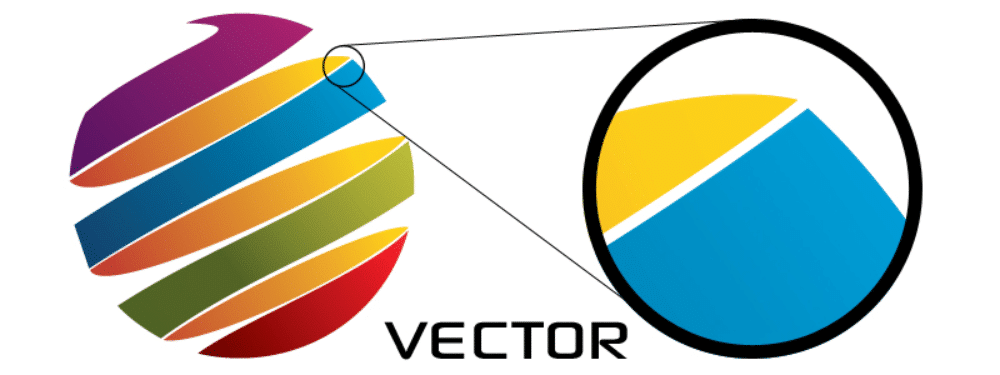
Image source: PrintCNX
Here's some information on vector images so it is easier to understand the distinction:
convert-to tiff
Do you want to know how we increased traffic by more than 1000 percent?
Join over 20,000 others to receive our weekly newsletter that contains insider WordPress tips!Subscribe Now
- Images are created using mathematical formulas that define geometric shapes , such as lines, polygons curvatures, circles and rectangles.
- Perfect for straight-edged images , such as line art.
- Since there aren't any color variations, they work for flat photos that have uniform colors.
- Use popular images such as logos, letterhead, and fonts.
- You can scale down or up without any loss in quality as they don't depend on pixels to create the total.
2. Both Terms Mean the Same Thing
Did you remember when we talked about the term JPEG and the way it stood as the Joint Photographic Experts Group? Yes, you read it; both JPEG along with JPG are abbreviations that refer to the identical ISO sub-committee.
3. Both Are Used for the Same Image Types
Since they are raster photos and not vectors, each of the .jpeg and .jpg file formats are best utilized for digital photography. Digital photographs contain a variety of color gradients that appear seamless when they are saved as JPEG/raster images. This means your site visitors will always be able to see a stunning photograph when saved as an .jpeg/.jpg and uploaded to your site.
Find out more about image file types and their impact on your website.
4. Both Lose Some Quality When Saved
Because the .jpeg in comparison to .jpg comparison is ineffective ( because they are exactly the same thing) Therefore, it is natural that the compression method used for each format of file -lossy compression results in some loss of image quality as the file size of the image decreases.
This also means that whichever extension of your file you choose ( either .jpeg or .jpg), your image's file size will be smaller than it had been originally, and this will result in faster loading time when uploaded to your site and seen by visitors to your site.
In the final analysis, JPEGand JPGs are the same thing . They serve only a handful of purposes that are to decrease the size of files to make them easier to view on the internet and allow users to compress their images upon saving. Then, name the image with a commonly used file extension that is known by a large number of.
Ask yourself: JPG vs JPEG Which one is better? From there, take your time because there is no difference. They're the same thing and any one you pick, is a matter of preference.
JPG vs JPEG 2000
If you've been searching for information regarding JPEGs or JPGs you might have come across the term JPEG 2000and was wondering what in the world it was. For one thing, it's not an option in most editors for images.
JPEG 2000 was an image encoding system created by the Joint Photographic Experts Group in 2000. It was developed to be better than the JPEG standard currently in place. Actually, it was developed to provide lossless compression for Images by using the most advanced compression techniques on a discrete wavelength transformation.
If you're putting up a lot of images and photos to your site, you won't want to deliver poor pages to your users surely? Our servers are lightning fast and 24/7 expert assistance from WordPress experts. Find out more about our plans
It was a means for people to enhance their photos and save them in JPEGs, without degrading the quality of the image.
Here are some of the most important features of JPEG 2000:
- Advance Compression Tools:unlike standard JPEGs, JPEG 2000 was able to perform both lossy and lossless compression ( even on a single image file).
- Progressive Decodingenables users to view an image with a lower-quality version of an image while the entire process of downloading as background. As more data downloads, it improves the quality of the picture for the user.
- Higher Compression Ratios:when it is lossy compression, JPEG 2000 can compress an image as much as 20-200 percentages over JPEG and maintain the same image quality when compared to a JPEG image that's the same size.
Additionally, JPEG 2000:
- Provides preservation of transparency in images.
- Can be used to describe grayscale, bi-level color, palette-color, as well as full-color images.
- Includes unlimited amounts of private or specific-purpose information within metadata.
- Can handle larger image sizes ( greater than 64K x 64K pixels), with no tilting.
- Ultra-low latency, which is especially helpful for live TV broadcasts.
- Scalability both in resolution and quality.
JPEG 2000 Limitations
Though JPEG 2000 has plenty of great features and seems to be the next best format for digital images for coding but there are many reasons it's still not widely used by the majority of people:
- No general browser support ( only supports Safari).
- Incompatible with JPEG ( must encode an entirely new standard as well as support the original JPEG).
- Encoding JPEG 2000 files can be processing intensive for CPUs, which can strain servers and cause slowdowns.
- Some cameras and sites aren't ready for the format , because it's still not widely accepted.
Because of its limitations, you'll have a hard time finding this JPEG 2000 file format as an option to save your digital photos. While it's certainly superior to JPEG, until it is universally accepted that you'll probably run through a lot of compatibility issues that make your life more difficult as a webmaster more than it is.
Convert Image Files to JPG: Common Methods
There are many ways of saving your digital images in .jpg or .jpeg files. We'll look at several.
1. Windows Paint
If you're using Windows You can effortlessly save any image in .jpeg or .jpg using Windows Paint. Just upload your image to Windows Paint, go to Fileand then save as select the location of the file, then name your photo, and then select JPEG (*.jpg, *.jpeg, *.jpe, *.jfif)from the dropdown options. 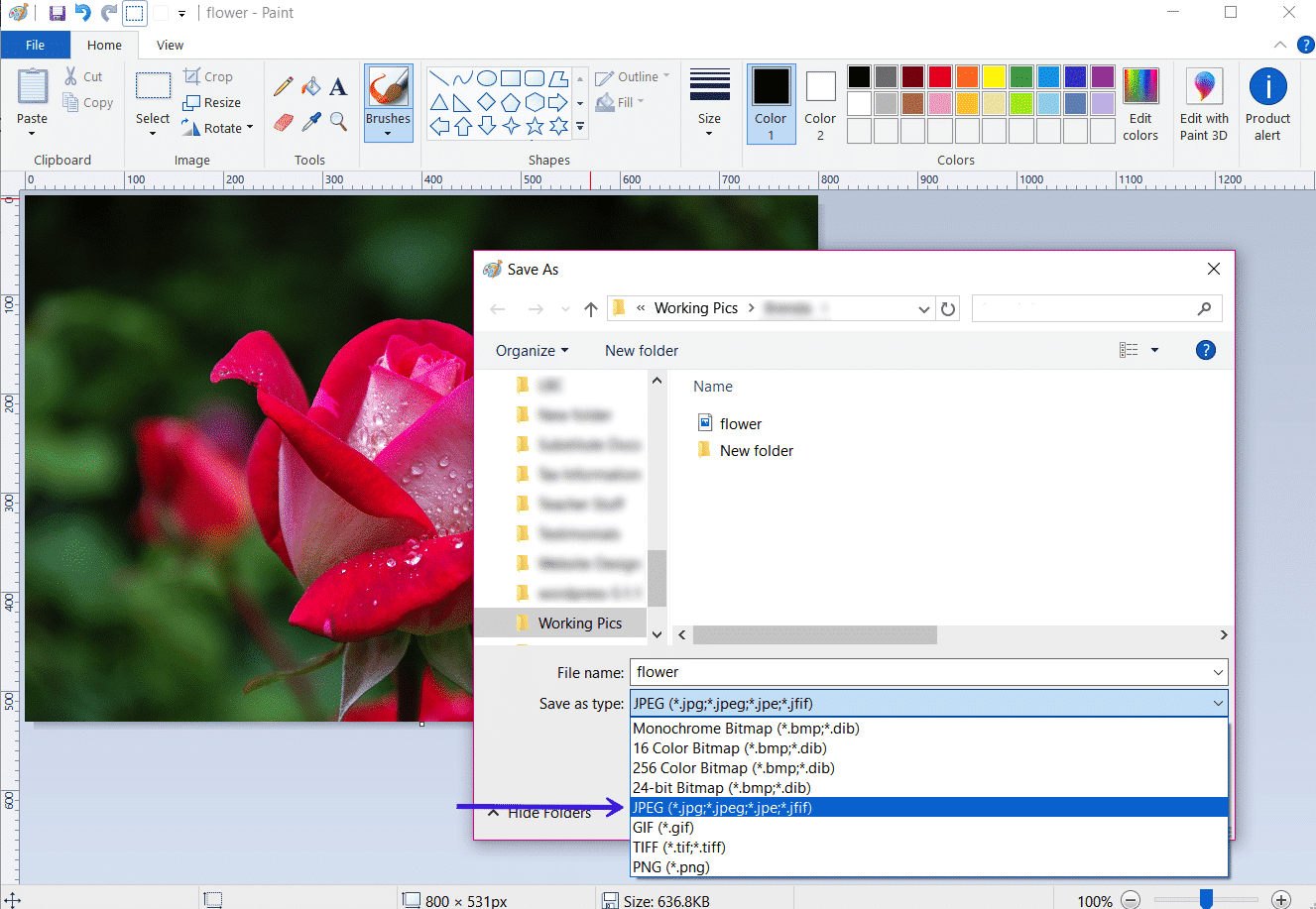
Windows Paint
Then click save.
2. Affinity Designer
Affinity Designer is comparable to other image editing software such like Adobe Photoshop. When saving images as a JPG using a software like this, start by opening the application and uploading your image. Make any changes you wish to make and click "Filethen Export.... Next, click on the JPEG icon, select what quality ( best, high medium or low), and select to export. 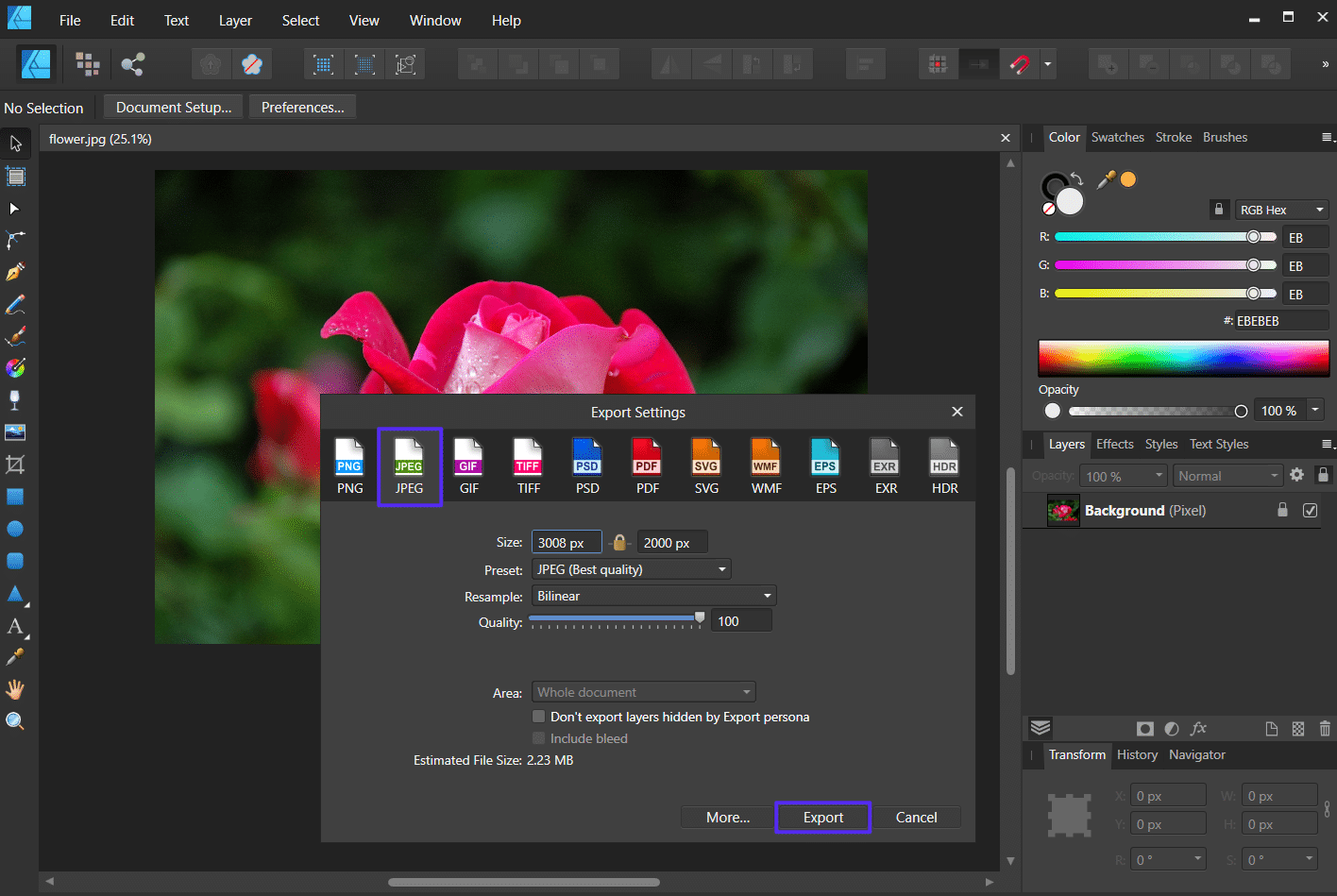
Affinity Designer
After that save, the File Save As dialog will open so you can choose a file destination, name your image, and then confirm that you are saving the file as a JPG. 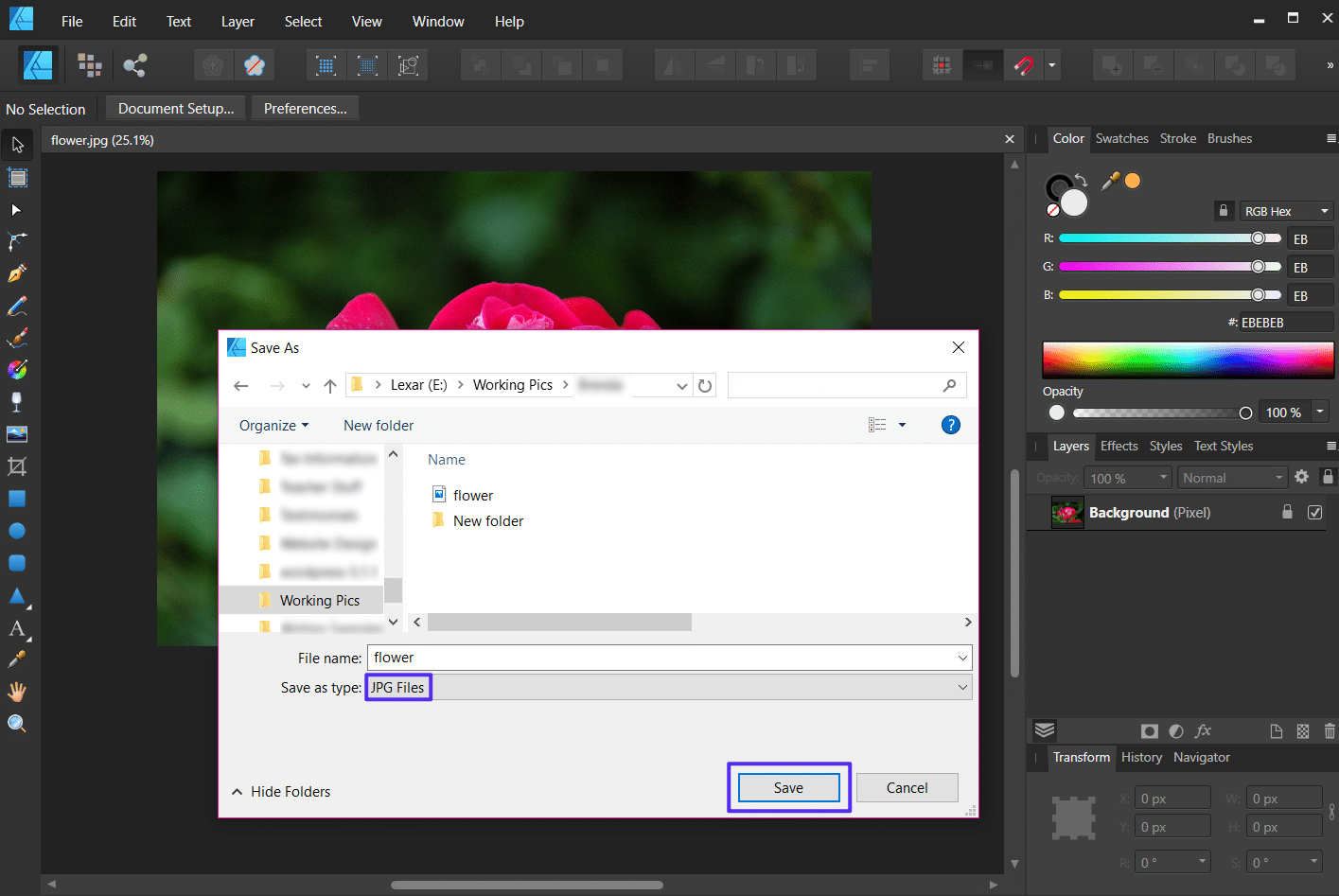
"Save as" in Affinity Designer
Click Save.
3. Online Converter Tool
If you're interested in converting images to JPG, there are many free online jpg converter tools to aid you. For example, FileZigZag is a free online file converter that's simple to use. Just drag and drop your image file or upload the file select the type of file for conversion, enter an email address, and then click Convert. 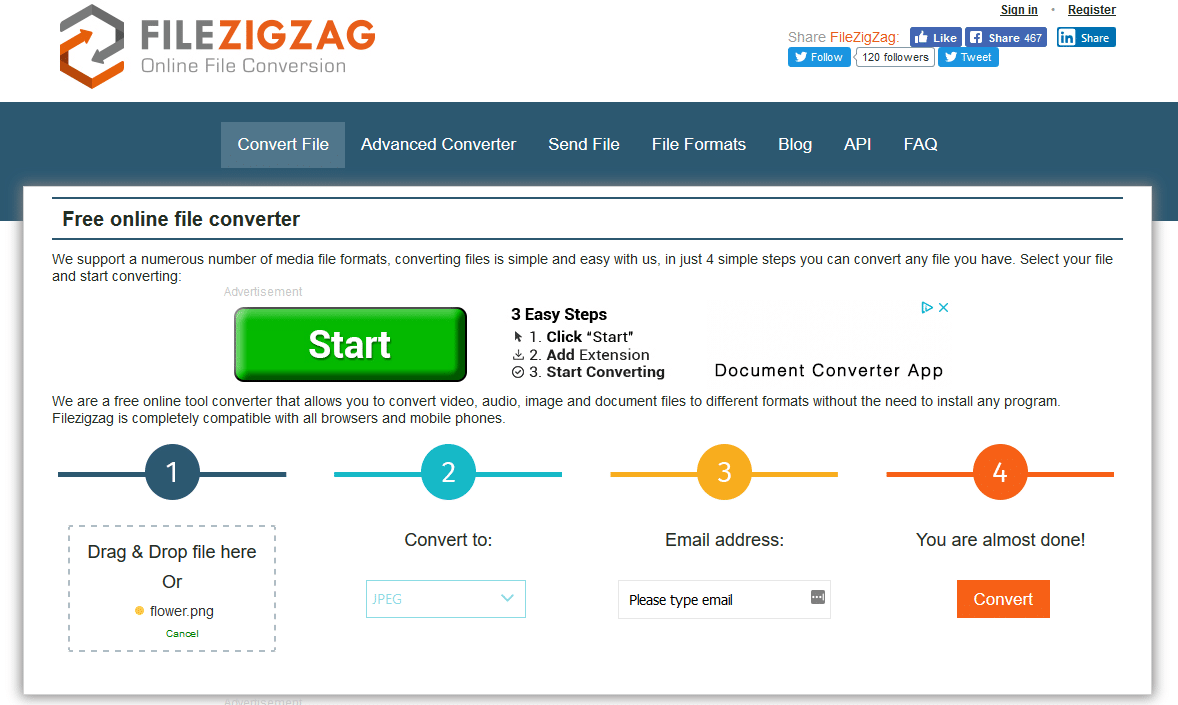
Convert png into jpeg FileZigZag
Of course, you might not be willing to divulge your email address in exchange for the conversion of your photo into a JPG. We've also compiled some other free and premium options to check out:
- XnConvert : perfect for advanced image editors that require many image file formats, with the capability to bulk convert and the option to run Windows, Mac, or Linux.
- Zamzar :a free online tool that is ideal for users with high-quality Images ( up to 50MB) who would like the option of having the final product emailed to them or not.
- adapter : a simple image converter which supports batch images. It also converts them quickly and runs on both macOS as well as Windows.
Of course, these are just some of the available choices you can select if want to convert images to JPG.JPG vs JPEG What's the difference? What about JPEG 2000? Find the answer (and more) in our extensive guide! CLICK TO TWEET
Summary
JPG is a better choice than JPEG are among the most used formats and methods of compression for people looking to store and save digital images. This is especially important for website owners that want to display attractive images and maintain an exceptional user experience.
There's good news for you: no which of .jpeg, .jpg or .webp file formats, you're likely be able to achieve the same result: beautiful images that are loaded extremely quickly for site users.
Reduce time, money and maximize site performance with:
- Help is available immediately from WordPress experts in hosting, 24 hours a day.
- Cloudflare Enterprise integration.
- The global reach of the audience is enhanced by 28 data centers throughout the world.
- Optimization using Built-in Application Controlling Performance.
All of that and much more, in one plan with no long-term contracts, assisted migrations, and a 30-day-money-back-guarantee. Check out our plans or speak to our sales representatives to find the best plan for you.
Use this tool to compress image
Comments
Post a Comment